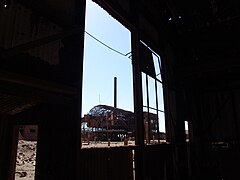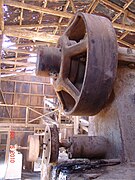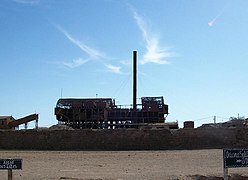Humberstone and Santa Laura Saltpeter Works
| UNESCO World Heritage Site | |
|---|---|
 | |
| Location | Iquique Province, Tarapacá Region, Chile |
| Includes | Humberstone, Chile 20°12′30″S 69°47′43″W / 20.20833°S 69.79528°W Santa Laura, Chile 20°12′40″S 69°48′45″W / 20.21111°S 69.81250°W |
| Criteria | Cultural: (ii), (iii), (iv) |
| Reference | 1178bis |
| Inscription | 2005 (29th Session) |
| Extensions | 2011 |
| Endangered | 2005–2019[1] |
| Area | 573.48 ha (1,417.1 acres) |
| Buffer zone | 12,055 ha (29,790 acres) |
| Coordinates | Coordinates: 20°12′32″S 69°48′18″W / 20.209°S 69.805°W |
 Location of Humberstone and Santa Laura Saltpeter Works in Tarapacá Region | |
Humberstone and Santa Laura Saltpeter Works are two former saltpeter refineries located in northern Chile. They were declared a UNESCO World Heritage Site in 2005, as a testament to the historical importance of saltpeter mining in Chile and the culture and social agenda that developed around it in the late 19th century.[2][3] The works were placed on the World Heritage List in Danger that same year, due to the fragility of the derelict buildings, but was removed in 2019.[4]
Geography[]
Humberstone and Santa Laura are located 45km east of the city of Iquique in the Atacama Desert in the Tarapacá Region in northern Chile[3]. Other saltpeter works or "nitrate towns" include Chacabuco, Maria Elena, Pedro de Valdivia, Puelma and Aguas Santas among many others.
Humberstone[]

View of Humberstone

Humberstone Locomotive

Humberstone Church

Humberstone Theater
Santa Laura[]
Santa Laura plant

Saltpeter Works

Abandoned Machinery
History[]
This section does not cite any sources. (May 2020) |
In 1872, the Guillermo Wendell Nitrate Extraction Company founded the saltpeter works of Santa Laura, while the region was still a part of Peru. In the same year, James Thomas Humberstone founded the "Peru Nitrate Company", establishing the works of "La Palma". Both works grew quickly, becoming busy towns characterized by English-style buildings.
While La Palma became one of the largest saltpeter extractors of the whole region, Santa Laura did not do well, as production was low. It was taken over in 1902 by the Tamarugal Nitrate Company. In 1913 Santa Laura halted its production until the Shanks extraction process was introduced, which enhanced productivity.
However the economic model collapsed during the Great Depression of 1929 because of the development of the synthesis of ammonia by the Germans Fritz Haber and Carl Bosch, which led to the industrial production of fertilizers. Practically bankrupt, both works were acquired by COSATAN (Compañía Salitrera de Tarapacá y Antofagasta) in 1934. COSATAN renamed La Palma into "Oficina Santiago Humberstone" in honor of its founder. The company tried to produce a competitive natural saltpeter by modernizing Humberstone, which led to its becoming the most successful saltpeter works in 1940.
Both works were abandoned in 1960 after the rapid decline that caused COSATAN to disappear in 1958. In 1970, after becoming ghost towns, they were declared national monuments and opened to tourism. In 2005 they were declared a World Heritage Site by UNESCO.
See also[]
References[]
- ^ "The Humberstone and Santa Laura Saltpeter Works site (Chile), removed from the List of World Heritage in Danger". UNESCO. Retrieved 7 July 2019.
- ^ "21 World Heritage Sites you have probably never heard of". Daily Telegraph.
- ^ Jump up to: a b "Humberstone and Santa Laura Saltpeter Works". UNESCO. Retrieved 28 March 2021.
- ^ "The Humberstone and Santa Laura Saltpeter Works site (Chile), removed from the List of World Heritage in Danger". UNESCO. Retrieved 26 March 2021.
External links[]
- Oficina Humberstone, formerly La Palma
- Chile's Mining Past Draws Tourists North: Santa Laura's pictures explaining saltpeter process
- "Decision: 29 COM 8B.51". Decisions of the 29th Session of the World Heritage Committee (PDF). Durban: UNESCO. 2005. p. 142.
- Humberstone and Santa Laura Saltpeter Works UNESCO property on google arts and culture
- Saltpeter works in Chile
- Mining museums
- Museums in Tarapacá Region
- History museums in Chile
- Mines in Chile
- Atacama Desert
- Ghost towns in South America
- Former populated places in Chile
- World Heritage Sites in Chile








